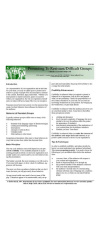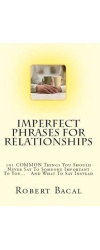Conflict Management And Resolution Series: #1
Exorcise Blame In Your Company (Part 1)
In this two part article, which is a part of our new series on managing and resolving conflict, we look at how leaders can move their organizations from blaming to a process of problem solving, which actually ends up FIXING things.
There’s a difference between BLAMING and holding people ACCOUNTABLE. Blaming is an emotional act that causes fear, discomfort and strong dislike.
We live in a blaming society. Whether one looks at politics, organizations, or even personal relationships, we, as a society, seem to place great importance on finding some entity or person to blame for almost everything. Political parties blame each other (watch any governmental body meeting or election campaign). Unions blame management. Management blames union. Spouses blame each other.
Perhaps it’s just part of our natures, or the way we are brought up, but it seems that we are unable to separate the process of blaming from the process of making things better. This separation is of critical importance if we are to improve anything anywhere, but particularly applies to the workplace. While Edward Deming tells us to “drive out fear”, we should also be prepared to “drive out blame” from our workplaces. Perhaps the single most important barrier to improvement is blame!
To understand the issue, we need to make some very important distinctions among terms…terms that will help us to recognize the destructiveness of the blaming process.
Blaming refers to an emotion-filled process where we assign responsibility for a past event, but also assign a negative emotions to that responsibility. The blamer is attempting to avoid responsibility by pointing to someone else, and may be experiencing fear, anger or other feelings. The receiver (or blamee) tends to experience loss of face, embarrassment, fear and anger.
The problem with the blaming process is not so much to do with responsibility (which is a good thing), but with the emotions that are attached to that responsibility. People who are experiencing anger, humiliation, Esc are not likely to focus their energy of solving or preventing a problem from occurring. Clearly, they will be oriented toward defending themselves from experiencing the negative emotions attached to blame.
Taking or assigning responsibility is a subtlety different process. First, it can apply to past, present or future events, where blame is almost exclusively focused on the past. Second, assigning responsibility does not have the excess emotional content of blaming. Responsibility language is different than blaming language. As a manager, you may assign responsibility for a task without assigning blame. And you can hold someone accountable for results without blaming, also. Sometimes the distinctions however lie in the delivery of language, even the tone of language. Take a look at the following two statements:
“If you had done your work on time, we wouldn’t be in this mess“.
“Your responsibility is to fulfill your work commitments on time”. When your work wasn’t available I had to speak to the Minister (Secretary) without the information I needed.”
Even without hearing the tone we can see that the first statement sounds somehow like blame…that the mess is the employee’s fault. The second is more of a factual statement, and lacks the emotional content of the first. Also, consider which of the statements above is more conducive to improving things, or preventing delays of this sort in the future. Which is a prelude for problem-solving, and which is a prelude to argument?
Problem-Solving is the third term we need to define. The hallmark of a problem-solving process is that it is focused on the present and the future. It’s goal is to fix something occurring now, or prevent something from happening again. It is THE critical process for improving organizations, individual performance, and relationships. Non-blaming problem-solving lacks the negative emotions attached to blaming, and allows a more harmonious approach to the issue, since it’s purpose is not to find a donkey to pin a tail on, but prevention. It is less personal and more systems-oriented.
Often the problem solving process rests on an understanding of the past, and an understanding of the causes or root causes of a particular issue. It may include:
- clarifying the problem solving goal or purpose
- collecting data to help understand past and present
- diagnosis (identifying sources of the problem)
- formulating hypotheses for explaining
- formulating a strategy for addressing the problem
- evaluating the strategy (more data collection)
However, nowhere in problem solving is their a need to assign blame, or create the kinds of humiliation and negative emotions that accompany blame.
Problem solving is a complicated process, and Total Quality Management leaders (Deming, Crosby, Juran) have added much to the discussion of how one goes about problem-solving. In fact, one senior manager in government commented that the TQM material is simply an extensive, efficient and more advanced method of solving problems.
In the second part of this article, we’ll cover some specifics about how managers, supervisors and executives can alter their own specific behaviors, and how they communicate to kill blame, and reap the benefits of doing so.
Robert Bacal is the author of over twenty books on conflict, communication, customer service and management. You can view his books by clicking here.
For more on conflict management and conflict resolution techniques, visit the Free Conflict Management site for over 500 articles, guides and tips to enable you to handle conflict more effectively in the workplace and at home..
Part Two, the conclusion of this article, can be found here. We look at what managers and leaders can do to start building a non-blaming culture.





